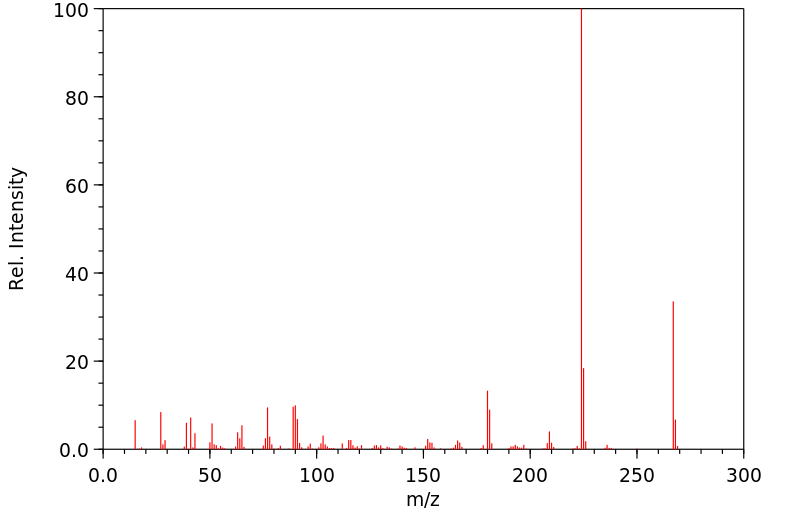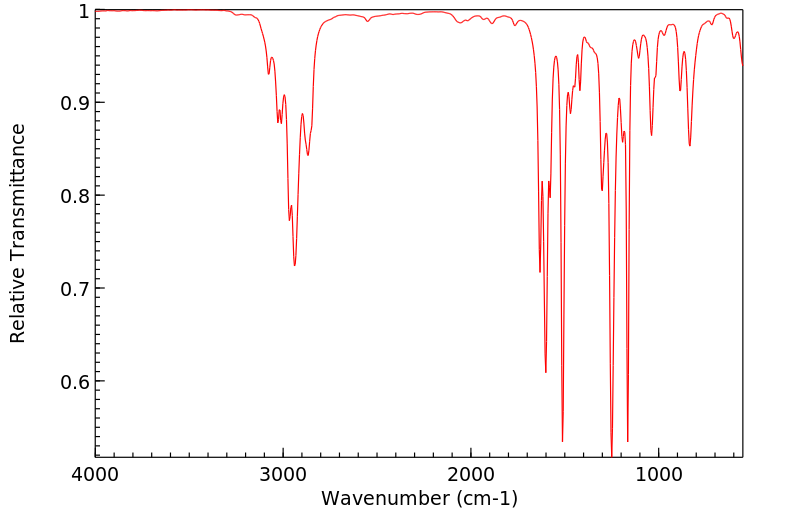N-(4-甲氧基苯亚甲基)-4-丁基苯胺 | 26227-73-6
中文名称
N-(4-甲氧基苯亚甲基)-4-丁基苯胺
中文别名
N-(4-甲氧基苯亚甲基)-4-丁基苯胺;N-(4-甲氧基亚苄基)-4-丁基苯胺;N-(4-甲氧基苄烯)-4-丁胺;N-(4-甲氧基亚苄基)对丁基苯胺;液晶MBBA
英文名称
N-(4-methoxybenzylidene)-4-(n-butyl)aniline
英文别名
N-(4-methoxybenzylidene)-4-butylaniline;4'-methoxybenzylidene-4-butylaniline;MBBA;N-(4-butylphenyl)-1-(4-methoxyphenyl)methanimine
CAS
26227-73-6
化学式
C18H21NO
mdl
MFCD00009464
分子量
267.371
InChiKey
FEIWNULTQYHCDN-UHFFFAOYSA-N
BEILSTEIN
——
EINECS
——
-
物化性质
-
计算性质
-
ADMET
-
安全信息
-
SDS
-
制备方法与用途
-
上下游信息
-
文献信息
-
表征谱图
-
同类化合物
-
相关功能分类
-
相关结构分类
物化性质
-
熔点:21.1°C
-
沸点:410.55°C (rough estimate)
-
密度:1.027 g/mL at 25 °C (lit.)
-
闪点:113 °C
-
溶解度:溶于甲醇
-
物理描述:Cloudy light yellow liquid. (NTP, 1992)
-
稳定性/保质期:
避免接触强氧化剂。
计算性质
-
辛醇/水分配系数(LogP):5.1
-
重原子数:20
-
可旋转键数:6
-
环数:2.0
-
sp3杂化的碳原子比例:0.277
-
拓扑面积:21.6
-
氢给体数:0
-
氢受体数:2
安全信息
-
危险品标志:Xi
-
安全说明:S26,S37/39
-
危险类别码:R36/37/38
-
RTECS号:BW9550000
-
海关编码:2925290090
-
WGK Germany:3
-
危险性防范说明:P264,P280,P337+P313,P305+P351+P338,P302+P352,P332+P313,P362
-
危险性描述:H315,H319
-
储存条件:将物品存放在阴凉、干燥的紧密容器中。
SDS
模块 1. 化学品
1.1 产品标识符
: N-(4-甲氧基苯亚甲基)-4-丁基苯胺
产品名称
1.2 鉴别的其他方法
MBBA
1.3 有关的确定了的物质或混合物的用途和建议不适合的用途
仅用于研发。不作为药品、家庭或其它用途。
模块 2. 危险性概述
2.1 GHS-分类
皮肤刺激 (类别 2)
眼睛刺激 (类别 2A)
特异性靶器官系统毒性(一次接触) (类别 3)
2.2 GHS 标记要素,包括预防性的陈述
象形图
警示词 警告
危险申明
H315 造成皮肤刺激。
H319 造成严重眼刺激。
H335 可能引起呼吸道刺激。
警告申明
预防
P261 避免吸入粉尘/烟/气体/烟雾/蒸气/喷雾.
P264 操作后彻底清洁皮肤。
P271 只能在室外或通风良好之处使用。
P280 穿戴防护手套/ 眼保护罩/ 面部保护罩。
响应
P302 + P352 如皮肤接触:用大量肥皂和水清洗。
P304 + P340 如吸入: 将患者移到新鲜空气处休息,并保持呼吸舒畅的姿势。
P305 + P351 + P338 如与眼睛接触,用水缓慢温和地冲洗几分钟。如戴隐形眼镜并可方便地取
出,取出隐形眼镜,然后继续冲洗.
P312 如感觉不适,呼救中毒控制中心或医生.
P321 具体治疗(见本标签上提供的急救指导)。
P332 + P313 如发生皮肤刺激:求医/ 就诊。
P337 + P313 如仍觉眼睛刺激:求医/就诊。
P362 脱掉沾染的衣服,清洗后方可重新使用。
储存
P403 + P233 存放于通风良的地方。 保持容器密闭。
P405 存放处须加锁。
处置
P501 将内容物/ 容器处理到得到批准的废物处理厂。
2.3 其它危害物 - 无
模块 3. 成分/组成信息
3.1 物 质
: MBBA
别名
: C18H21NO
分子式
: 267.37 g/mol
分子量
组分 浓度或浓度范围
N-(4'-Methoxybenzylidene)-4-butylaniline
-
化学文摘登记号(CAS 26227-73-6
No.) 247-527-4
EC-编号
模块 4. 急救措施
4.1 必要的急救措施描述
一般的建议
请教医生。 向到现场的医生出示此安全技术说明书。
吸入
如果吸入,请将患者移到新鲜空气处。 如呼吸停止,进行人工呼吸。 请教医生。
皮肤接触
用肥皂和大量的水冲洗。 请教医生。
眼睛接触
用大量水彻底冲洗至少15分钟并请教医生。
食入
切勿给失去知觉者通过口喂任何东西。 用水漱口。 请教医生。
4.2 主要症状和影响,急性和迟发效应
人体吸入引起高铁血红蛋白形成,一定浓度后引起苍白病。一般2~4小时或更长时间后发作,
据我们所知,此化学,物理和毒性性质尚未经完整的研究。
4.3 及时的医疗处理和所需的特殊处理的说明和指示
无数据资料
模块 5. 消防措施
5.1 灭火介质
灭火方法及灭火剂
用水雾,抗乙醇泡沫,干粉或二氧化碳灭火。
5.2 源于此物质或混合物的特别的危害
碳氧化物, 氮氧化物
5.3 给消防员的建议
如必要的话,戴自给式呼吸器去救火。
5.4 进一步信息
无数据资料
模块 6. 泄露应急处理
6.1 作业人员防护措施、防护装备和应急处置程序
使用个人防护用品。 避免吸入蒸气、烟雾或气体。 保证充分的通风。 人员疏散到安全区域。
6.2 环境保护措施
不要让产品进入下水道。
6.3 泄漏化学品的收容、清除方法及所使用的处置材料
用惰性吸附材料吸收并当作危险废物处理。 放入合适的封闭的容器中待处理。
6.4 参考其他部分
丢弃处理请参阅第13节。
模块 7. 操作处置与储存
7.1 安全操作的注意事项
避免接触皮肤和眼睛。 避免吸入蒸气和烟雾。
一般性的防火保护措施。
7.2 安全储存的条件,包括任何不兼容性
贮存在阴凉处。 使容器保持密闭,储存在干燥通风处。
打开了的容器必须仔细重新封口并保持竖放位置以防止泄漏。
7.3 特定用途
无数据资料
模块 8. 接触控制和个体防护
8.1 容许浓度
最高容许浓度
没有已知的国家规定的暴露极限。
8.2 暴露控制
适当的技术控制
根据良好的工业卫生和安全规范进行操作。 休息前和工作结束时洗手。
个体防护设备
眼/面保护
带有防护边罩的安全眼镜符合 EN166要求请使用经官方标准如NIOSH (美国) 或 EN 166(欧盟)
检测与批准的设备防护眼部。
皮肤保护
戴手套取 手套在使用前必须受检查。
请使用合适的方法脱除手套(不要接触手套外部表面),避免任何皮肤部位接触此产品.
使用后请将被污染过的手套根据相关法律法规和有效的实验室规章程序谨慎处理. 请清洗并吹干双手
所选择的保护手套必须符合EU的89/686/EEC规定和从它衍生出来的EN 376标准。
身体保护
防渗透的衣服, 防护设备的类型必须根据特定工作场所中的危险物的浓度和数量来选择。
呼吸系统防护
如危险性评测显示需要使用空气净化的防毒面具,请使用全面罩式多功能防毒面具(US)或ABEK型
(EN
14387)防毒面具筒作为工程控制的候补。如果防毒面具是保护的唯一方式,则使用全面罩式送风防
毒面具。 呼吸器使用经过测试并通过政府标准如NIOSH(US)或CEN(EU)的呼吸器和零件。
模块 9. 理化特性
9.1 基本的理化特性的信息
a) 外观与性状
形状: 浑浊的, 液体
颜色: 黄色
b) 气味
无数据资料
c) 气味阈值
无数据资料
d) pH值
无数据资料
e) 熔点/凝固点
无数据资料
f) 沸点、初沸点和沸程
无数据资料
g) 闪点
113 °C - 闭杯
h) 蒸发速率
无数据资料
i) 易燃性(固体,气体)
无数据资料
j) 高的/低的燃烧性或爆炸性限度 无数据资料
k) 蒸气压
无数据资料
l) 蒸汽密度
无数据资料
m) 密度/相对密度
1.027 g/cm3 在 25 °C
n) 水溶性
无数据资料
o) n-辛醇/水分配系数
无数据资料
p) 自燃温度
无数据资料
q) 分解温度
无数据资料
r) 粘度
无数据资料
模块 10. 稳定性和反应活性
10.1 反应性
无数据资料
10.2 稳定性
无数据资料
10.3 危险反应
无数据资料
10.4 应避免的条件
无数据资料
10.5 不相容的物质
强氧化剂
10.6 危险的分解产物
其它分解产物 - 无数据资料
模块 11. 毒理学资料
11.1 毒理学影响的信息
急性毒性
无数据资料
皮肤刺激或腐蚀
无数据资料
眼睛刺激或腐蚀
无数据资料
呼吸道或皮肤过敏
无数据资料
生殖细胞突变性
无数据资料
致癌性
IARC:
此产品中没有大于或等于 0。1%含量的组分被 IARC鉴别为可能的或肯定的人类致癌物。
生殖毒性
无数据资料
特异性靶器官系统毒性(一次接触)
吸入 - 可能引起呼吸道刺激。
特异性靶器官系统毒性(反复接触)
无数据资料
吸入危险
无数据资料
潜在的健康影响
吸入 吸入可能有害。 引起呼吸道刺激。
摄入 如服入是有害的。
皮肤 通过皮肤吸收可能有害。 造成皮肤刺激。
眼睛 造成严重眼刺激。
接触后的征兆和症状
人体吸入引起高铁血红蛋白形成,一定浓度后引起苍白病。一般2~4小时或更长时间后发作,
据我们所知,此化学,物理和毒性性质尚未经完整的研究。
附加说明
化学物质毒性作用登记: BW9550000
模块 12. 生态学资料
12.1 生态毒性
无数据资料
12.2 持久性和降解性
无数据资料
12.3 潜在的生物累积性
无数据资料
12.4 土壤中的迁移性
无数据资料
12.5 PBT 和 vPvB的结果评价
无数据资料
12.6 其它不良影响
无数据资料
模块 13. 废弃处置
13.1 废物处理方法
产品
将剩余的和不可回收的溶液交给有许可证的公司处理。
联系专业的拥有废弃物处理执照的机构来处理此物质。
受污染的容器和包装
按未用产品处置。
模块 14. 运输信息
14.1 联合国危险货物编号
欧洲陆运危规: - 国际海运危规: - 国际空运危规: -
14.2 联合国运输名称
欧洲陆运危规: 非危险货物
国际海运危规: 非危险货物
国际空运危规: 非危险货物
14.3 运输危险类别
欧洲陆运危规: - 国际海运危规: - 国际空运危规: -
14.4 包裹组
欧洲陆运危规: - 国际海运危规: - 国际空运危规: -
14.5 环境危险
欧洲陆运危规: 否 国际海运危规 国际空运危规: 否
海洋污染物(是/否): 否
14.6 对使用者的特别提醒
无数据资料
模块 15 - 法规信息
N/A
模块16 - 其他信息
N/A
反应信息
-
作为反应物:描述:N-(4-甲氧基苯亚甲基)-4-丁基苯胺 在 二甲基苯基硅烷 、 potassium hydroxide 作用下, 以 甲苯 、 甲醇 、 水 为溶剂, 以88 %的产率得到4-butyl-N-[(4-methoxyphenyl)methyl]aniline参考文献:名称:用于亚胺氢化硅烷化和羰基还原胺化的磁性可回收硼烷路易斯酸催化剂摘要:使用Piers硼烷在烯丙基官能化的Fe 3 O 4表面上实现了硼Lewis酸催化剂的多相化。所得催化剂为亚胺氢化硅烷化反应和还原胺化反应提供了优异的活性和可回收性,可在温和的反应条件下获得多种胺。DOI:10.1002/cssc.202400058
-
作为产物:描述:参考文献:名称:Heldman, Margaret A.; Gilson, D. F. R., Canadian Journal of Chemistry, 1980, vol. 58, # 21, p. 2246 - 2249摘要:DOI:
-
作为试剂:参考文献:名称:The Influence of Liquid Crystal Ordering on Reversible Radical Dissociation摘要:DOI:10.1080/10587250108028691
文献信息
-
Allylic C(sp<sup>3</sup>)–H alkylation <i>via</i> synergistic organo- and photoredox catalyzed radical addition to imines作者:Jiaqi Jia、Rajesh Kancherla、Magnus Rueping、Long HuangDOI:10.1039/d0sc00819b日期:——A new catalytic method for the direct alkylation of allylic C(sp3)–H bonds from unactivated alkenes via synergistic organo- and photoredox catalysis is described. The transformation achieves an efficient, redox-neutral synthesis of homoallylamines with broad functional group tolerance, under very mild reaction conditions. Mechanistic investigations indicate that the reaction proceeds through the N-centered
-
Selective Radical–Radical Cross-Couplings: Design of a Formal β-Mannich Reaction作者:Jenna L. Jeffrey、Filip R. Petronijević、David W. C. MacMillanDOI:10.1021/jacs.5b05376日期:2015.7.8organocatalysis. Transient β-enaminyl radicals derived from ketones via enamine and oxidative photoredox catalysis readily combine with persistent α-amino radicals in a highly selective hetero radical-radical coupling. This novel pathway to γ-aminoketones is predicated upon the use of DABCO as both a base and an electron transfer agent. This protocol also formally allows for the direct synthesis of
-
Nematic to smectic texture transformation in MBBA by in situ synthesis of silver nanoparticles作者:P. K. Sudhadevi Antharjanam、Edamana PrasadDOI:10.1039/b909428h日期:——The present study describes the texture changes in ‘nematic’ N-(4-methoxybenzylidene)-4-butylaniline (MBBA) by in situ synthesis of silver nanoparticles in the system without any external reducing or stabilizing agents. Optical polarizing microscopy (OPM), differential scanning calorimetry (DSC), nuclear magnetic resonance (NMR) spectroscopy, Fourier-transform infrared (FT-IR) spectroscopy, and scanning本研究描述了“向列相”中的织构变化 N-(4-甲氧基亚苄基)-4-丁基苯胺 (工商管理硕士)通过在系统中原位合成银纳米颗粒而无需任何外部还原剂或稳定剂。利用光学偏振显微镜(OPM),差示扫描量热法(DSC),核磁共振(NMR)光谱,傅立叶变换红外(FT-IR)光谱以及扫描和透射电子显微镜(SEM和TEM)来了解机理。中的纹理转换的详细信息工商管理硕士。实验结果共同表明,银纳米颗粒是通过还原银离子而产生的。工商管理硕士经过热处理,然后从“向列”到“近晶”的清晰纹理转变。“近亲”工商管理硕士-Ag NP共轭物在快速冷却时形成稳定的发光玻璃相,在银等离子体激元吸收时,光激发时最大发射波长为500 nm。
-
Excited-state palladium-catalysed reductive alkylation of imines: scope and mechanism作者:Rajesh Kancherla、Krishnamoorthy Muralirajan、Magnus RuepingDOI:10.1039/d2sc02363f日期:——transformations. We describe the development of excited-state palladium-catalyzed reductive alkylation of imines with alkyl bromides. The new methodology shows broad functional group tolerance and can additionally be applied in the direct three-component reaction of aldehydes, anilines, and alkyl bromides to give the alkyl amines under mild reaction conditions. Time-resolved photoluminescence experiments
-
Regioselective Synthesis of γ-Amino Esters, Nitriles, Sulfones, and Pyrrolidinones by Nickel-Catalyzed Reductive Coupling of Aldimines and Activated Alkenes作者:Chien-Hung Yeh、Rajendra Prasad Korivi、Chien-Hong ChengDOI:10.1002/anie.200800825日期:2008.6.16
表征谱图
-
氢谱1HNMR
-
质谱MS
-
碳谱13CNMR
-
红外IR
-
拉曼Raman
-
峰位数据
-
峰位匹配
-
表征信息
同类化合物
(R)-3-(叔丁基)-4-(2,6-二异丙氧基苯基)-2,3-二氢苯并[d][1,3]氧杂磷杂环戊烯
(2S,3R)-3-(叔丁基)-2-(二叔丁基膦基)-4-甲氧基-2,3-二氢苯并[d][1,3]氧杂磷杂戊环
(2S,2''S,3S,3''S)-3,3''-二叔丁基-4,4''-二甲氧基-2,2'',3,3''-四氢-2,2''-联苯并[d][1,3]氧杂磷杂戊环
(2R,2''R,3R,3''R)-3,3''-二叔丁基-4,4''-二甲氧基-2,2'',3,3''-四氢-2,2''-联苯并[d][1,3]氧杂磷杂戊环
(2-氟-3-异丙氧基苯基)三氟硼酸钾
(+)-6,6'-{[(1R,3R)-1,3-二甲基-1,3基]双(氧)}双[4,8-双(叔丁基)-2,10-二甲氧基-丙二醇
麦角甾烷-6-酮,2,3,22,23-四羟基-,(2a,3a,5a,22S,23S)-
鲁前列醇
顺式6-(对甲氧基苯基)-5-己烯酸
顺式-铂戊脒碘化物
顺式-四氢-2-苯氧基-N,N,N-三甲基-2H-吡喃-3-铵碘化物
顺式-4-甲氧基苯基1-丙烯基醚
顺式-2,4,5-三甲氧基-1-丙烯基苯
顺式-1,3-二甲基-4-苯基-2-氮杂环丁酮
非那西丁杂质7
非那西丁杂质3
非那西丁杂质22
非那西丁杂质18
非那卡因
非布司他杂质37
非布司他杂质30
非布丙醇
雷诺嗪
阿达洛尔
阿达洛尔
阿莫噁酮
阿莫兰特
阿维西利
阿索卡诺
阿米维林
阿立酮
阿曲汀中间体3
阿普洛尔
阿普斯特杂质67
阿普斯特中间体
阿普斯特中间体
阿托西汀EP杂质A
阿托莫西汀杂质24
阿托莫西汀杂质10
阿托莫西汀EP杂质C
阿尼扎芬
阿利克仑中间体3
间苯胺氢氟乙酰氯
间苯二酚二缩水甘油醚
间苯二酚二异丙醇醚
间苯二酚二(2-羟乙基)醚
间苄氧基苯乙醇
间甲苯氧基乙酸肼
间甲苯氧基乙腈
间甲苯异氰酸酯








